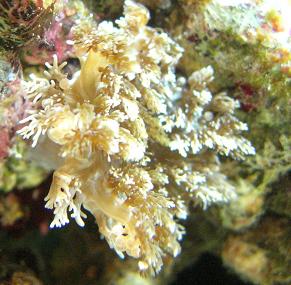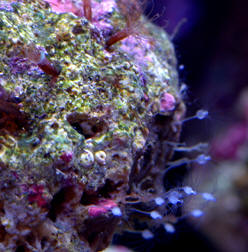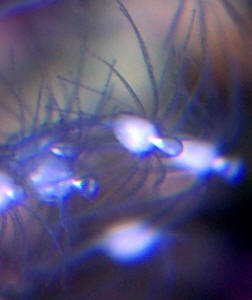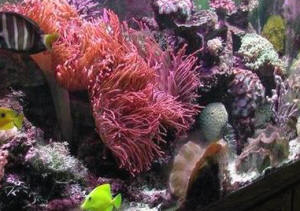|
FAQs on Identification of Stinging-Celled
Animals 5
Related Articles: Cnidarians, Water Flow, How Much
is Enough,
Related FAQs: Cnidarian IDs 1, Cnidarian IDs 2, Cnidarian IDs 3,
Cnidarians ID 4,
Cnidarians ID 6,
Cnidarian ID 7,
Cnidarian ID 8, Cnidarian ID 9, Cnidarian ID 10, Cnidarian ID 11, Cnidarian ID 12, Cnidarian ID 13, Cnidarian ID
14, Cnidarian ID
15, Cnidarian ID
16, Cnidarian ID 17, Cnidarian ID 18, Cnidarian ID 19, Cnidarian ID 20, Cnidarian ID 21, Cnidarian ID 22, Cnidarian ID 23, Cnidarian ID 24, Cnidarian ID 26, Cnidarian ID 27, Cnidarian ID 28,
Cnidarian
ID 29,
Cnidarian ID 30,
Cnidarian ID 31,
& Anemone ID 1, Aiptasia
ID 1, Stony Coral ID
1, Mushroom Identification,
Soft Coral ID, Alcyoniid ID, Xeniid ID,
|

|
SW cnid. ID 4/9/06 Hi Bob, <Brian> Any idea what
this is. Started off with one on living rock about a
year ago, now 4 / 5. About 2 cm across, move slowly across the rock
although often stay in one place for ages. Looks like there is a
central mouth so guess anemone of some sort. Are they reef safe?
<Mmm, looks to be a soft or hard coral... def. a Cnidarian,
Anthozoan of sorts. Evidence of your good care. I'd definitely
keep this> Regards to you and your team. Hope you are all well.
Thanks
Brian
<Yes, thank you. Bob Fenner> |
|

|
Strange living things on rock, maybe Aiptasia and hydroids?
2 different ones. 3/24/06 Hi! I've read
all the Aiptasia FAQ's and ID's, but again, to be sure I
wanted to know with some pictures. The two linked below
contain one picture zoomed out of a brown sort of coral that looks
like a yellow polyp but brown and small. <Is a small Polypoid
animal of some sort. Not an Actinarian/anemone as far as I can make
out> It's at the top, not really that in
focus. Then there are these white things sticking out
the side of the rock, and the second picture shows a close-up of
them. <These are hydroids of some species> Is the brown one
up top Aiptasia? <Doubtful> It retracts it's tentacles
when I touch it, but the stalk still sits there. The
white ones don't retract or seem to be affected at
all. They also don't seem to be moving or bothering
a Zoanthid nearby. picture one: http://i.xkinetic.net/3-06/22nd/plants_id.jpg
close-up of the white ones: http://i.xkinetic.net/3-06/22nd/plants_idclose.jpg
Thanks again! I've asked people what these are, but
never got a clear concise answer. I'm hoping you
guys can come through! - Art
<Thank you for sending this along. Bob Fenner> |
|


|
| Damaged Leather coral and an unknown sp.
3/16/06 Good day WWM Crew, <John> I find your site to be
very helpful and I would much appreciate your opinions regarding
two corals in my 72gal reef tank. My inquiry concerns a damaged
toadstool leather (seems they are much talked about) and I am
hoping you could help identify a red branching coral I have. I
purchased my leather coral about 2 months ago and it seems to be
doing great with the exception of an injury I must have overlooked
while purchasing it. One of the protruding areas of the
coral around the top seems to have been split or cut. <Not
uncommon... capitula get nicked, broken in moving...> I am
unaware how the damage occurred. The coral opens up on
either side of the wound as you can see in the picture I attached.
<Yes> I have looked over the archives you guys have and some
other net sources and I am getting the feeling that I should cut
the end portion off as it appears mostly cut off and pulling
downwards on the coral. In essence, I'm wondering if
I should make a clean cut and let the wound heal, or leave the
coral as is, or if I should try to heal the current wound somehow.
<I would hold off here (for now)... perhaps increase your weekly
Lugol's/Iodine treatments... Likely will self-heal or shed this
bit/piece. Cutting might well lead to a host of other troubles>
The second part of my inquiry has to do with a red coral that a
family member purchased for me. My biggest concerns with
this coral are that I don't know what it is; I can't tell
if it is healthy, and off hand I believe it will require more light
than my tank can offer. I have attached a picture of the
coral. It is made up of red branches that are very loose
and fragile. Currently some of the branch tips are white
(I'm worried that this is a bad sign). The coral is
by no means flat like the 'gorgonia' species; it is more of
a tangled mass. My best guess would be that it is a
'swifia' or similar type of Sea Fan, <Maybe... but it
looks more like a member of the Hydrozoan suborder Stylasterina to
me: http://wetwebmedia.com/sylasterina.htm
Not easily kept unfortunately> although I don't see any
polyps on it. From what I've read, some sea fans
require almost no light while other sea fans require extensive
amounts of light. <Yes> Any help in identifying this specific
species and giving me an idea of its chances for survival in a tank
with two '50% 10,000k / 50% actinic 55W' bulbs would be
much appreciated. Thanks in advance, -John <Do look "very
close" at the stalks... presence of "fine hairs" are
semi-definitive here. Bob Fenner> |
|
 
|
| Coral/Anemone ID 2/20/05 Bob, Do you have any idea what
this coral is? It appears to be some type of leather
(Sarcophyton) with very long tentacles. Do you know the
specific name? <<Actually, those are
anemones. Probably "Bubble Tip" Entacmaea
quadricolor. Best Regards. AdamC.> |
|

|
Hydroid identification... no graphic - 2/15/2006 Hey
pros got a quick question for you. I was browsing through
your array of posts and articles when I stumbled upon the
"Hydrozoan" section. I looked through the photos
and found one that is similar to something I have in my
tank. The picture I'm referring to is under a post
entitled "Bad boyz hydroids- 12-30-03. The picture
shows small tube-like structures protruding from the live rock with
tiny little white heads. <Covers many species...> I have
something similar in my aquarium. There are several small
(1/16 to 1/8 on an inch) solid tubes, purple in color (covered in
coralline algae) that appear to be growing out form the coralline algae
(or maybe the coralline is just growing onto it). On the end is a tiny
filamentous structure (looks like a clear bubble but it's very
small so hard to tell) but in either case it looks as if it could pull
inside the tude. <? Not retractable> These little tubes have been
there for at least a few months if not year, I never paid attention to
them, and I have never noticed them bother anything. There
are no corals growing near them, but I assuming if I see them in that
spot then they are probably growing other places too. All corals
(Shrooms, xenias, colt, zoos, and gorgonians) seem to be doing
fine. Can I do a test by placing a small xenia, perhaps,
near this "hydroid" to see what happens? Are these
little tubes always "bad" or can they be beneficial/neutral
creatures as well? <As long as "stay small", to
themselves> I have seen other similar creatures that
live in tubes (some straight some coiled) that have feather duster like
heads. I'm certain these aren't harmful, but how do
you visually separate these from hydroids? <If trouble,
best to remove, denude from the rock> One post stated that they can
look like corals, algae, or jellyfish. That describes many
small creatures I see in my aquarium, how do I separate the good from
the bad? Thank you Jon <... a photo or drawing please. Bob
Fenner>
Sea fan approximation 02/12/06 WWM Crew,
<<Arnold>> I am requesting your assistance in identifying a
particular type of coral I have acquired. It is yellow in
color, resembles a dead tree in shape, and has white polyps protruding
out from the entirety of the structure. Any help you could
provide would be greatly appreciated. Thank you for your
time. Sincerely, Arnold <<No way to say without a sharp close-up
photo. But I'm going to venture a guess here and say you
have a non-photosynthetic gorgonian...will likely starve to death
within months. You really should research your livestock
BEFORE you acquire it my friend. Regards, EricR >>
Mushrooms invertebrate or soft corals? 2/9/06 I
have seen many forums sectionalized mushrooms as soft corals. however,
I am incline to believe they are closer in invertebrates. what is
confusing is not clear cut. <... Mushrooms (Order Corallimorpharia)
are not Soft Corals (Order Alcyonacea)... many stinging-celled animals
(and even some non-cnidarians!) are termed "corals" by
hobbyists and lay people. Much of their higher taxonomy here: http://wetwebmedia.com/cnidaria.htm
Bob Fenner>
Jellyfish?? 1/27/06 Hi. I have a 45
gallon reef tank with about 60-70 lbs of live rock and live
sand. My tank is in great condition just turning 1
year. :) I currently have hammer coral, waving
xenia (SP?), cabbage coral, candy, mushrooms (diff varieties) brain
coral, assorted polyps, and a another coral soft yellow and i cant for
the life of me remember the name. The tank only has
2 clown fish, 2 engineer gobies, 1 black and yellow clown fish
(gift from gf... She doesn't know name) 1 tiger pistol
shrimp, 1 arrow head crab, 1 fire
shrimp, 1 sally light foot (think that's
name) I have a not so standard setup as far as
filtration goes. I converted my sump into a fast water
refugium. In there I have 4 inches of coarse live
sand, live rock and assorted live plants and kelp, A
hitchhiker anemone white in color don't know what it is, and a
family of copepods all happy and growing. I have Eheim
filter filled with bio balls, and finally I set up a 10gallon tank as a
slow water refugium. the slow water refugium gets
water thru 1 air hose via gravity and gets returned to sump via
gravity. The slow water refugium has a large number of
copepods and other "buggers" I don't clean
them and pretty much let them be. Now after all that
rambling, recently only in my slow water refugium I have a
large growth of ... only what I can describe as small
anemones they are white and about 1/4 inch
long. The are attached to the glass via a small tube not
hard very short 1/16th inch then a disc with tentacles very fine and
numerous. The can sway and retract if
disturbed. there are a lot of them but I leave them be since
that is what I put the refugium in for. But after a
while the head of the anemones starts to change turns discus in
shape. then it starts to pulsate, then it breaks
off and what looks like a jelly fish ... kinda like a small slightly
opaque mushroom, swims around. they are
multiplying the swimming parts seem to disappear after a
while. Any Idea as to what this can
be? I can try a picture if that will help more
:) <Likely are some sort of scyphozoan,
Hydrozoan... Just as likely to cycle out. Bob Fenner> Thank you
Javier Fernandez
|
|

